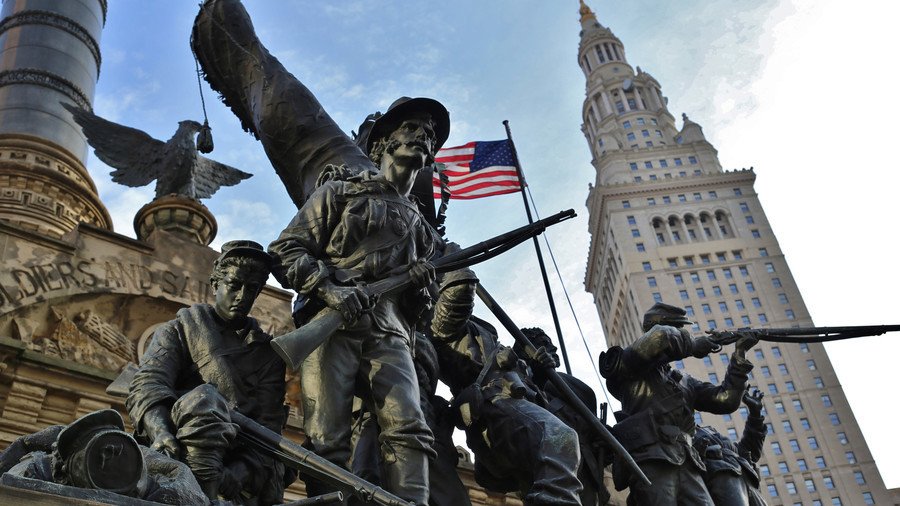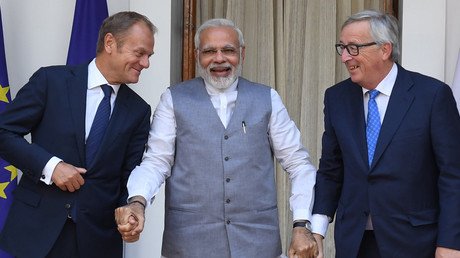All's fair in love and war: Trump's trade wars analyzed on all fronts of global battlefield

President Donald Trump vowed to make America great again, pledging to pull the US out of each and every unfair trade agreement, and to even out the trade imbalance with each and every partner.
Trump has shaken the foundations of global trade by breaking deals and imposing tariffs on friend and foe alike. Those countries have retaliated with tariffs on American products, pushing the world closer to an all-out trade war.
RT Business takes a look at how we got here.
TTP
As soon as Trump took to the helm of the world's largest economy, he proved to be a man of his word. During his first week in office, the US president abandoned the 12-nation trade pact known as the Trans-Pacific Partnership (TPP) as part of his 'America First' agenda, saying that the deal "was designed for China to come in, as they always do, through the back door and totally take advantage of everyone."
TTIP
The Transatlantic Trade and Investment Partnership (TTIP), which had been negotiated between the European Union and the US since 2013 during the Obama administration, was next on the chopping block. Shortly after taking office, Trump halted talks on the deal, saying that international trade agreements hurt US workers and the country's competitiveness.
In April, Donald Trump said the US might rejoin TPP. The following July, Washington and Brussels announced plans to restart negotiations for an agreement similar to the TTIP. Though Donald Trump has changed his aggressive rhetoric toward some of America's trade partners, he has managed to unleash several full-scale trade wars across the globe.
NAFTA
The longstanding trilateral North American Free Trade Agreement, which came into force in 1994 to unify the US, Canada and Mexico, was challenged by President Trump as well. He pledged to renegotiate the deal or break it. In July 2017, the White House provided a detailed list of changes to the agreement. While the deal is at a standstill, the Trump administration opted to slap its neighbors with tariffs on steel and aluminum exports. The measure came into force on June 1.
Canada
Apart from a 25-percent tariff on steel imports and a 10-percent tariff on aluminum imports, Washington introduced export tariffs of up to 24 percent on Canadian lumber. The measure that came into effect in April 2017 targets several forestry corporations, including West Fraser Mills, Tolko Marketing and Sales, J.D. Irving, Canfor Corporation, and Resolute FP Canada. According to the US, the lumber companies are subsidized by the government, which is not considered to be fair.
Mexico
Steel and aluminum tariffs are still the only trade assault committed by the US against its southern neighbor. However, Donald Trump has repeatedly slammed US companies for basing their production facilities in Mexico. During his election campaign, Trump pledged to impose tariffs – in the range of 15 percent to 35 percent – on firms moving their operations to Mexico.
European Union
The bloc was slapped with the same metal tariffs on the same date as Canada and Mexico. Brussels introduced tariffs worth $3.3 billion against US products. Washington pledged to impose a 20-percent tariff on cars imported from the EU, while Brussels threatened additional tariffs on $20 billion worth of the US imports. So far, the bloc agreed to buy more US soybeans and LNG in an attempt to avoid further escalation of the trade conflict.
China
Trump's trade battle against Beijing has been the fiercest. It started in late January with Washington imposing 30-percent tariffs on Chinese exports of solar panels and 20-percent tariffs on exports of washing machines. Later, as "a response to the unfair trade practices of China over the years," Washington placed a 25-percent tariff on more than 1,300 Chinese products, including flat-screen televisions, medical devices, aircraft parts and batteries. In response, Chinese authorities imposed tariffs ranging from 15 to 25 percent on 128 products it imports from the US. The list included aluminum, airplanes, cars, pork, and soybeans, as well as fruit, nuts, and steel piping.
In July, the Trump administration introduced 25-percent tariffs on Chinese goods worth $34 billion. Beijing immediately imposed retaliatory levies in the same amount on US imports. A second round of tariffs on imports worth $16 billion took effect earlier this month.
Apart from that, China – along with Russia, India, Japan and Turkey – was targeted with steel and aluminum tariffs. All the targeted nations filed complaints to the World Trade Organization (WTO) and introduced mirror measures.
For more stories on economy & finance visit RT's business section

















